|
|
|
Sort Order |
|
|
|
Items / Page
|
|
|
|
|
|
|
| Srl | Item |
| 1 |
ID:
132361
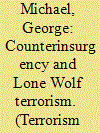

|
|
|
|
|
| Publication |
2014.
|
| Summary/Abstract |
This essay examines strategies to counter the threat of lone wolf terrorism. Lone wolves implement a tactical approach dubbed "leaderless resistance," which has become popular in several extremist subcultures. Although most episodes of lone wolf terrorism have not been highly destructive, there are notable exceptions that have claimed a substantial number of victims. The lone wolf trend should be contextualized in the evolution of conflict and strategy in which smaller and smaller entities figure prominently. Elements of the counterinsurgency doctrine can be applied to lone wolf terrorism. A comprehensive counterterrorism strategy must prepare for the prospect of lone wolf terrorism because of the increasing number of small-scale attacks, the large number of soft targets in contemporary society, and the potential damage that individuals can cause with the use of weapons of mass destruction.
|
|
|
|
|
|
|
|
|
|
|
|
|
|
|
|
| 2 |
ID:
132367
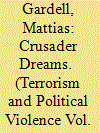

|
|
|
|
|
| Publication |
2014.
|
| Summary/Abstract |
The synchronized terror attacks on July 22, 2011 was the worst politically motivated assault in post-WW2 Norway. To the perpetrator, Anders Behring Breivik, 22/7 was a "marketing operation," designed to draw attention to his compendium, 2083: A European Declaration of Independence. While Breivik acted alone, his political philosophy is far from unique. Through a detailed analysis of the compendium's content, identifying the original authors whose texts Breivik used but did not always acknowledge, this essay discusses the political traditions that informed the assailant's worldview: Islamophobia (anti-Muslim racism), cultural conservative nationalism, antifeminism, and selected elements of White Power thought, far Right evangelical theology, and the Knights Templar tradition, all permeated by romantic male warrior ideals. The stunning violence of July 22 was a hyper-masculine performative act aimed at producing a heroic avant-garde of nationalist warriors who will rise to purge Europe from the corrupting influence of its internal enemies and defeat its external enemies. Through the cleansing fire of the civil war, he believes that a reborn Europe will arise to reclaim its ordained position of glory as the world's leading civilization. In the final analysis, Breivik's political philosophy may thus be recognized as a 21st-century articulation of the fascist legacy.
|
|
|
|
|
|
|
|
|
|
|
|
|
|
|
|
| 3 |
ID:
080345
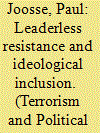

|
|
|
|
|
| Publication |
2007.
|
| Summary/Abstract |
Leaderless resistance is a strategy of opposition that allows for and encourages individuals or small cells to engage in acts of political violence entirely independent of any hierarchy of leadership or network of support. This article examines the development of the leaderless resistance strategy by the radical right and more recently by the radical environmentalist movement. While both movements use leaderless resistance to avoid detection, infiltration, and prosecution by the state, environmental groups like the Earth Liberation Front (ELF) benefit additionally because of the ideological inclusiveness that leaderless resistance fosters. Historically, ideological cleavages have rendered radical environmental groups such as Earth First! less effective than they would have been otherwise. Using leaderless resistance, however, the ELF eliminates all ideology extraneous to the specific cause of halting the degradation of nature. This elimination enables the ELF to mobilize a greater number of "direct actions
|
|
|
|
|
|
|
|
|
|
|
|
|
|
|
|
| 4 |
ID:
152862
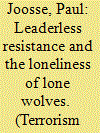

|
|
|
|
|
| Summary/Abstract |
“Leaderless resistance” and “lone wolf terrorism” are concepts that have steadily gained importance in the study of oppositional subcultures and terrorist groups, being used to describe the operational realities of a variety of terrorisms, from groups like Al Qaeda to Anders Breivik. In this article, I seek to describe leaderless resistance as a rhetorical construct, a meaning-conferring “ideology of effervescence” that lifts the spirits of both movement progenitors who advocate the strategy as well as incipient lone wolves who consider responding to their exhortations. Through an examination of the case of Wiebo Ludwig and the EnCana pipeline bombings of 2008–2009, I show how these rhetorics emerge in the interactions between activists and their political enemies. With this conception, we can (a) understand more fully the discursive/rhetorical dynamics involved in asymmetrical struggle, (b) problematize the acceptance of the organizational reality of leaderless resistance in the terrorism literature, and (c) question the assertion of some terrorism scholarship that refers to leaderless resistance and other ideologies of effervescence as hallmarks of the “new terrorism.”
|
|
|
|
|
|
|
|
|
|
|
|
|
|
|
|
| 5 |
ID:
168891
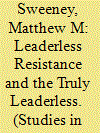

|
|
|
|
|
| Summary/Abstract |
The literature on leaderless resistance is conceptually cloudy. Nevertheless, such literature has bounded the theoretical framework of leaderless resistance around four criteria. These criteria are leaderless resistors cannot be members of organizations they represent; leaderless resistance is a tactical manifestation of an organization; the goal of leaderless resistance is to insulate members and leaders from prosecution; and leaderless resistance arises from organizational failure. Using a case study of the Phineas Priesthood, this work tests these boundaries via a directed content analysis of the Priesthood's ideological manifesto. This research finds that leaderless resistance is theoretically problematic and too often lone wolves and leader resistors are viewed equivalent when they are theoretically different. Scholars must theoretically differentiate between individuals who ascribe to leaderless concepts, organizations, or groups versus those who develop an ideological framework and exist outside a concept, organization, or group.
|
|
|
|
|
|
|
|
|
|
|
|
|
|
|
|
| 6 |
ID:
125081
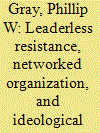

|
|
|
|
|
| Publication |
2013.
|
| Summary/Abstract |
This article examines various forms of "new terrorism," specifically the structure of "leaderless resistance," in connection with Robert Michels' idea of the "iron law of oligarchy." It is usually argued that "leaderless resistance" movements lack some of the typical obstacles of terrorist (and other) organizations, given their non-hierarchical and comparatively fluid natures. However, a new form of oligarchy develops in this type of movement, located in the propagation of key ideological concepts/arguments/symbols, the assigning of target preferences, and the elevation or demotion of others within the movement broadly. Rather than oligarchy forming via the material assets of organizations, an "ideational" oligarchy is created that shapes the goals of leaderless resistance movements: those leaders who are already established, and who control the means of communicating the movement's ideas to the widest audience, will impede the growth of groups and individuals within the movement that attempt to supplant their role. This article will use the examples of certain eco-terror groups (the Animal Liberation Front and the Earth Liberation Front) to explicate this development.
|
|
|
|
|
|
|
|
|
|
|
|
|
|
|
|
| 7 |
ID:
172177


|
|
|
|
|
| Summary/Abstract |
This paper presents a case study of the Earth Liberation Front (ELF), based on interviews of the group’s former affiliates. It examines the role of credit claims in organizing this underground leaderless resistance group’s activity. In addition to the external signaling functions of credit claims—demonstrating capability, issuing demands, and soliciting public support—credit claims serve a movement-building role in the ELF. By issuing credit claims in “aboveground” fora that other cells are known to read, ELF cells with no direct links are able to communicate information to one another. Credit-claiming communiqués serve four organizing functions for the ELF. They constitute the ELF underground as an imagined community, recruit new cells, set agendas for future actions, and enforce operational standards of behavior via an informal “peer review” process. This study of the ELF suggests broader insights, including possible organizing techniques that may be observed in white supremacist and Islamist cases.
|
|
|
|
|
|
|
|
|
|
|
|
|
|
|
|
| 8 |
ID:
132369


|
|
|
|
|
| Publication |
2014.
|
| Summary/Abstract |
School shootings have traditionally been interpreted as non-political acts. Empirical evidence, however, suggests that not all shootings are necessarily so different from political violence, at least in the shooter's own opinion. The article analyses 28 school rampage shootings in Europe, the U.S., and Canada from 1999-2011 to determine common and prevalent political elements in the shootings. The shootings are divided into three categories: shootings with overtly political communication (four cases), shootings with references to previous school rampage shootings (13 cases), and isolated incidents (11 cases). While it is possible to question whether the shootings were genuinely politically motivated, it is clear that the majority of school shooters link their deed to the agenda and beliefs presented by the Columbine shooters, which has created a sense of tradition, continuity, and imagined community among the shooters and their admirers, not unlike in cases of terrorism and political violence that are referred to as leaderless resistance.
|
|
|
|
|
|
|
|
|
|
|
|
|
|
|
|
|
|
|
|
|